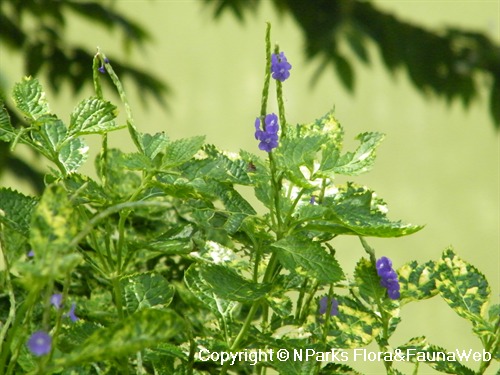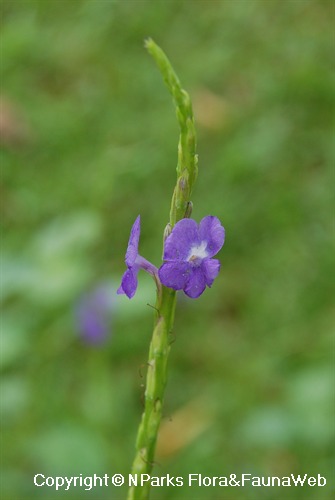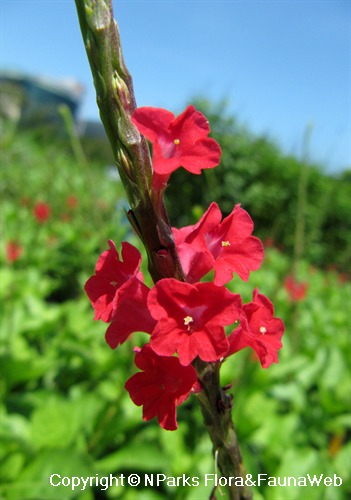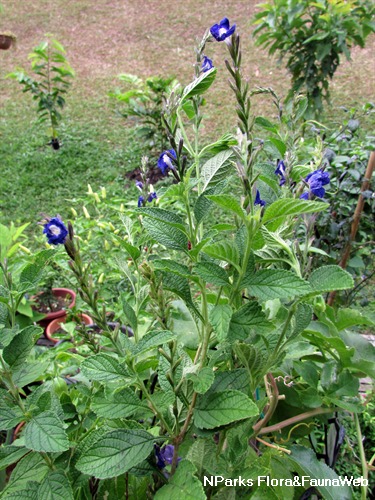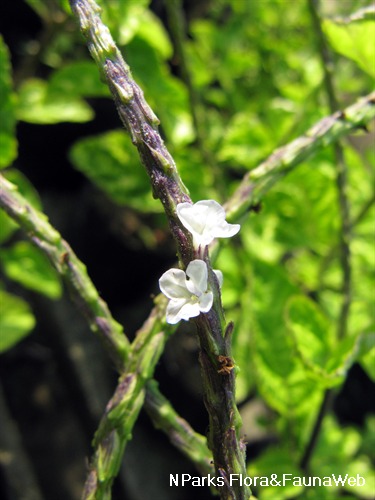
Back
Stachytarpheta cayennensis (Rich.) Vahl
| Family Name: | Verbenaceae |
| Synonyms: | Stachytarpheta australis Moldenke |
| Common Name: | White Snakeweed, Cayenne Snakeweed, Branched Porterweed |
Name
Classifications and Characteristics
| Plant Division | Angiosperms (Flowering Seed Plants) |
|---|---|
| Plant Growth Form | Shrub |
| Lifespan (in Singapore) | Perennial |
| Mode of Nutrition | Autotrophic |
Biogeography
| Native Distribution | Mexico, Central America, Carribean and South America, Peru and Argentina |
|---|---|
| Native Habitat | Terrestrial |
| Preferred Climate Zone | Tropical |
Description and Ethnobotany
| Growth Form | A perennial shrub, growing to about 0.4 m to 1.5 m tall. |
|---|---|
| Foliage | Leaves are ovate to elliptic, 2 - 9 cm long and 1 - 5 cm wide, hairy on upperside of leaves, smooth to hairy on the veins underneath, leaf margin crenate to dentate, petiole 1 - 1.5 cm long. |
| Stems | Sometimes woody at the base, smooth to shortly pubescent. |
| Flowers | Flowers are white, sometimes pale blue, clustered in spike inflorescence of about 20 - 45 cm long, located terminally. |
| Cultivation | Plant in a well-drained, fertile soil, enriched with compost. Remove spent flowers before they set seed to prevent excessive establishment of new seedlings. |
| Etymology | The genus Stachytarpheta comes from Greek, for spike "stachys" and thick "tarphys". It refers to the spike inflorescence found in many species of this genus. |
Landscaping Features
| Desirable Plant Features | Ornamental Flowers |
|---|---|
| Landscape Uses | General, Parks & Gardens, Small Gardens, Flowerbed / Border |
| Thematic Landscaping | Butterfly Garden |
Fauna, Pollination and Dispersal
| Fauna Pollination Dispersal Associated Fauna | Butterfly-Attracting, Bee-Attracting |
|---|---|
| Pollination Method(s) | Biotic (Fauna) |
Plant Care and Propagation
| Light Preference | Full Sun |
|---|---|
| Water Preference | Moderate Water |
| Plant Growth Rate | Moderate |
| Rootzone Tolerance | Well-Drained Soils, Fertile Loamy Soils |
| Propagation Method | Seed, Stem Cutting |
Foliar
| Foliage Retention | Evergreen |
|---|---|
| Mature Foliage Colour(s) | Green |
| Prominent Young Flush Colour(s) | Green |
| Foliar Type | Simple / Unifoliate |
| Foliar Arrangement Along Stem | Opposite |
| Foliar Shape(s) | Non-Palm Foliage |
| Foliar Venation | Pinnate / Net |
| Foliar Margin | Dentate |
| Foliar Apex - Tip | Acute |
| Foliar Base | Acute |
Floral (Angiosperm)
| Flower & Plant Sexuality | Bisexual Flowers |
| Flower Colour(s) | White |
|---|---|
| Flower Texture(s) | Smooth |
| Flower Grouping | Cluster / Inflorescence |
| Flower Symmetry | Bilateral |
| Individual Flower Shape | Salverform |
| Inflorescence Type | Spike |
| Flowering Period | Free-Flowering |
Fruit, Seed and Spore
| Fruit Classification | Simple Fruit |
|---|---|
| Fruit Type | Indehiscent Dry Fruit |
Image Repository
Others
| Master ID | 30986 |
|---|---|
| Species ID | 5373 |
| Flora Disclaimer | The information in this website has been compiled from reliable sources, such as reference works on medicinal plants. It is not a substitute for medical advice or treatment and NParks does not purport to provide any medical advice. Readers should always consult his/her physician before using or consuming a plant for medicinal purposes. |

